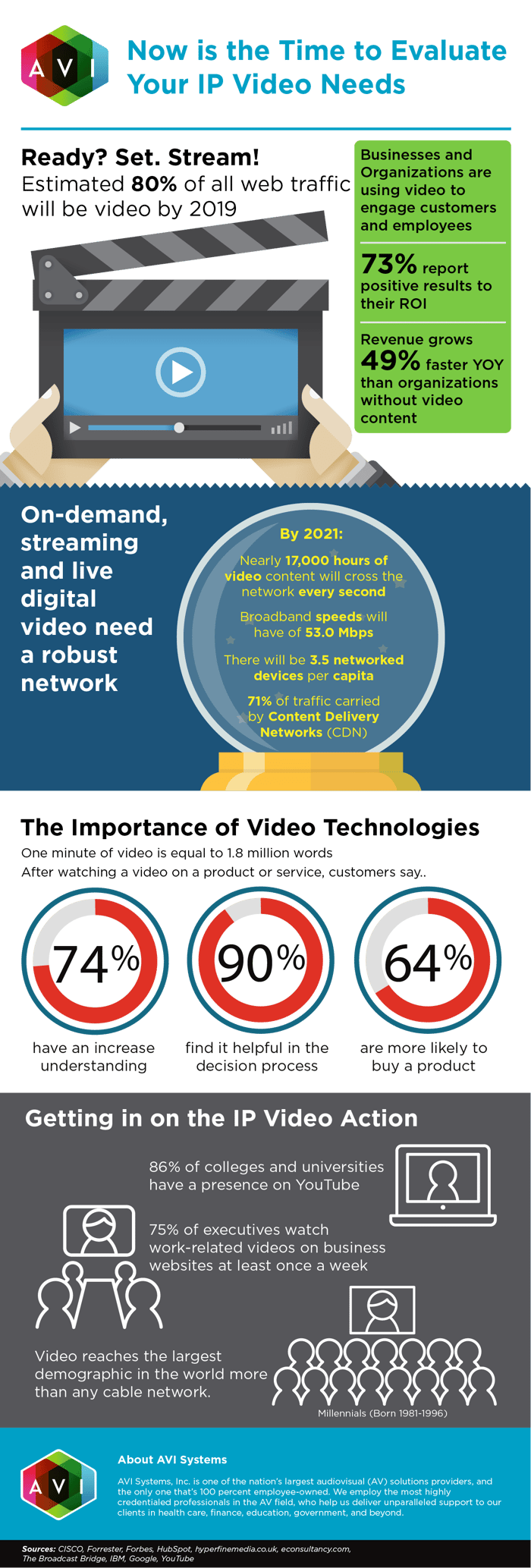While your next townhall or executive broadcast might not garner ratings like that of Game of Thrones, the technology behind your broadcast matters.
Like many other technologies, Internet Protocol Television (IPTV) is popular among consumers and poised to make a big impact on business.
In basic terms, IPTV is a protocol that enables live or on-demand video/TV programming to be transmitted digitally over a broadband network. It brings shows like Stranger Things to our mobile devices and allows us to binge watch our favorite Netflix shows, all while providing an alternative to cable and satellite TV in the form of SlingTV, Hulu, and others.
IPTV has so far proven to be a hit because it allows for granular control over when and where we watch the shows we love. As IPTV moves into the business world, we’ll be able to similarly improve the user experience in the workplace and increase opportunities for streaming and distributing company-owned multimedia content.

Why IPTV Matters
IPTV takes the next step into the digital age by shifting from purpose-built televisions and cabling to the broadband infrastructure that’s rapidly expanding all throughout the world.
Unlike cable, an IPTV-based solution can service multiple devices without significant investment in hardware or infrastructure. This makes it a convenient alternative for the mobile age. Familiarity with these types of solutions will also help organizations increase user adoption rates among millennials and “cord-cutters," people who move away from cable in favor of a wireless connection.
Since IPTV facilitates seamless, high-speed transmission of a tremendous amount of rich video content, it also stands to make a positive impact on businesses.
- Enterprises can facilitate meetings, seminars, and training events around the world.
- They can enrich the customer experience through timely, compelling communication.
- Business users can access company content through existing devices, including computers, mobile devices, digital TVs with a set-top device, or Smart TVs.
- Organizations can better monitor and report on utilization and reduce costs by delivering video and TV over IP networks.
Kinds of IPTV Services
IPTV is intended to be fully interactive no matter what content you choose. Not only should you get the snappy performance you expect from a conventional television, but you may gain access to interactive features like search, navigation, and catch-up.
The main types of IPTV services include:
- Video-on-Demand. An on-demand IPTV video catalog is stored on the hard disk in the set-top box or in the cloud.
- Live. Live events are captured through digital recording and streamed directly to the IPTV device.
- Delayed. IPTV provides access to time-shifted content so you can rewind or fast forward like with a DVR.
History and Outlook
The basic idea of IPTV has been around since 1995 in the form of online video-on-demand. However, today’s IPTV implementation is far more powerful and sophisticated.
In 1996, Adobe designed the Flash Web browser plug-in to allow webmasters to share videos on their websites. However, early implementations were error-prone.
It wasn’t until the 2000s, with the emergence of smartphones and the growth of broadband, that video content started to become mainstream. Sites like YouTube (founded 2005) experienced phenomenal growth and now serves about one billion hours of content daily.
As people shift to mobile, demand for video grows: More than half of video views come from mobile devices. Mobile video views are outpacing mobile device adoption worldwide, suggesting users can still fit more video into their lives—if they have a way of accessing it.
IPTV meets the need for a versatile, hardware-agnostic platform that gives users access to videos they want, when they want it—the opposite of TV’s traditional business model.
With robust broadband increasingly available, IPTV arrives at the perfect historical moment. Global IPTV revenues are expected to near $80 billion by 2020.
Learn More
To learn more about how IPTV can help you with your content production and broadcasting, read this case study to discover how Midco upgraded their production method.








